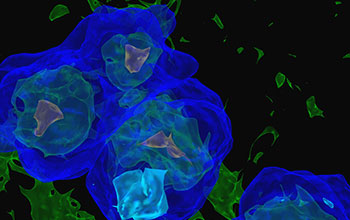Multimedia Gallery
Impact of radiation from early stars on primordial gas
This image shows the impact of radiation from early stars on surrounding primordial gas in the early universe. Early stars, fueled by molecular hydrogen (green), release high-energy radiation that creates regions of ionized gas (blue). When a star is active, the surrounding molecular hydrogen is completely dissipated, preventing further star formation. As stars decay, radiation levels decline and molecular hydrogen begins to reform. After decay, molecular hydrogen concentrates within the residual ionization "bubbles" that remain after the star's extinction.
This simulation was created at the Texas Advanced Computing Center (TACC). TACC is supported by the National Science Foundation, The University of Texas at Austin, the UT System, and grants from other federal agencies. As a leading resource provider in the NSF XSEDE (Extreme Science and Engineering Discovery Environment) project, TACC is one of 11 centers across the country providing leadership-class computing resources to the national research community. To learn more, visit the TACC website Here. (Date of Image: 2007-08)
Credit: Paul A. Navratil, Texas Advanced Computing Center, The University of Texas at Austin; Jarrett L. Johnson and Volker Bromm, Department of Astronomy, The University of Texas at Austin; Thomas H. Greif, Institute for Theoretical Astrophysics, University of Heidelberg, Germany
Images and other media in the National Science Foundation Multimedia Gallery are available for use in print and electronic material by NSF employees, members of the media, university staff, teachers and the general public. All media in the gallery are intended for personal, educational and nonprofit/non-commercial use only.
Images credited to the National Science Foundation, a federal agency, are in the public domain. The images were created by employees of the United States Government as part of their official duties or prepared by contractors as "works for hire" for NSF. You may freely use NSF-credited images and, at your discretion, credit NSF with a "Courtesy: National Science Foundation" notation.
Additional information about general usage can be found in Conditions.
Also Available:
Download the high-resolution JPG version of the image. (29.2 MB)
Use your mouse to right-click (Mac users may need to Ctrl-click) the link above and choose the option that will save the file or target to your computer.



